How To Find Entry Points Using Multiple Time Frame Analysis
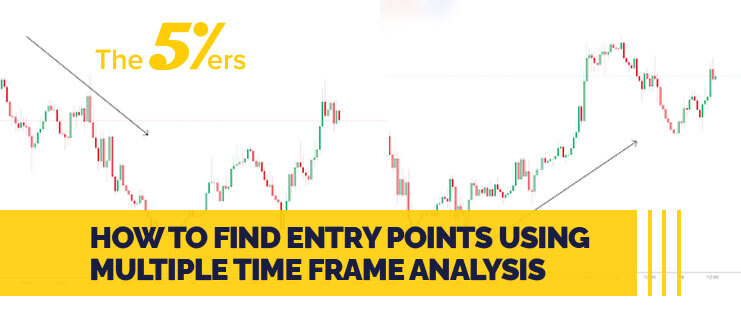
Multiple Time Frame Analysis
Analyzing the forex market for potential direction changes is only half of the battle. Most beginner traders are able to look at a chart and make a relatively good assumption as to whether the market is going to be continuing course, or reversing, depending on the relevant price action.
However, when it comes to entry points and exit points, this is where most traders fail. Having a great entry is key to your success within the forex markets as this dictates your risk to reward and therefore overall consistency in your trading. This is where multiple time frames come into the picture….
In this article, we are going to be looking at how you can find perfect entries in the forex market by using multiple time frame analysis to structure your positions. Let’s find out more!
How To Find Perfect Trading Entry Points Using Multiple Time Frames
Finding perfect entries in the forex market is very much possible and it’s actually not as tricky as most traders think. The key to doing so is simply using the same technical analysis you’re using on the higher time frames, but also on the lower time frames.
Before breaking down the example trades and step-by-step method to ‘sniping’ entries, we need to understand the basics of multiple time frame analysis and the importance of high risk to reward trades.
What Is Multiple Time Frame Analysis?
Multiple time frame analysis is a very simple concept that has been used by forex traders for many years. The logic is simple, you use all available time frame charts to build a much more detailed picture of price movement.
What does this look like in principle?
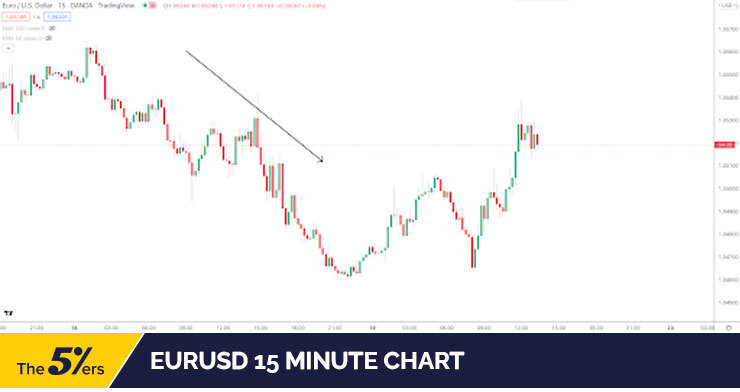
Well, let’s think about EURUSD on the 15-minute chart. On the chart, you’re seeing a bearish trend. The majority of traders would then be looking for selling opportunities, thinking that if they were taking long positions they would be catching a falling knife.
However, traders using multiple time frame analysis would also take a look at the hourly chart and the daily chart, for instance. These higher time frames may show a completely different picture and perhaps even a bullish picture.
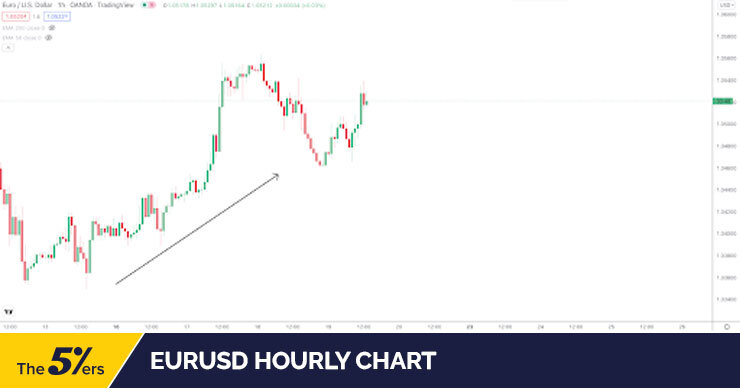
This would completely change the bias and show that ideally, you need to be looking at buys on the 15-minute chart, rather than looking for selling opportunities.
This is the principle of multiple time frame analysis and is used across various strategies, from EMA trading strategies to support and resistance strategies.
Why Are Perfect Entries Important In Forex Trading?
Finding a perfect entry is important and it’s not just so you can get a lovely screenshot for Instagram.
Having a great entry actually massively decreases the risk you’re taking on when you enter the position. Not only is the risk reduced, but the possible reward can also be massively increased as you gain experience with these kinds of entries.
Take AUDNZD here… We are expecting the price to reject this flip support/resistance level, so we are looking to take sells, right?
If we enter the daily time frame then we are looking at a 1:2 risk to reward ratio.
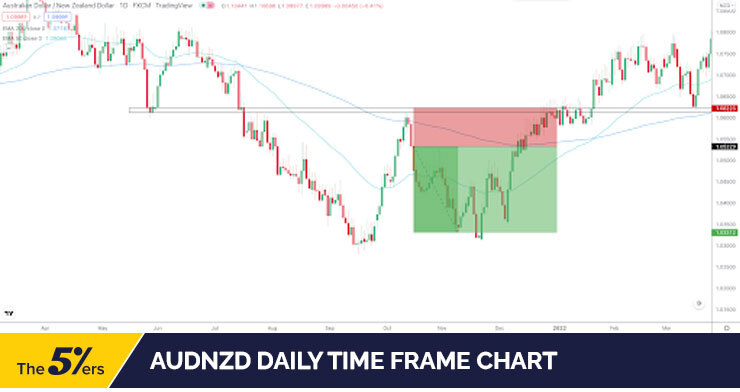
If we enter on a lower time frame, we are looking at a 1:5 risk-to-reward ratio. This is of course much more profitable but also allows us to remove our risk of break-even much sooner than if we had entered later.
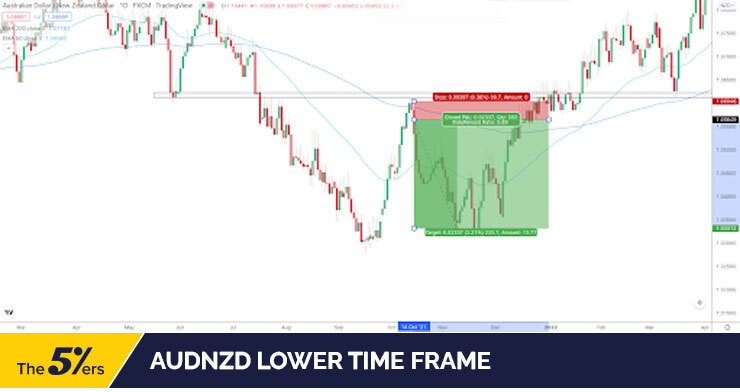
If you were risking £100 in this trade, you’re looking at a £300 difference. Compound that £300 difference for the next few years, with every single trade getting potentially a better risk to reward ratio. This would make a huge difference to your profitability!
Finding Forex Trade Entries (Multiple Examples)
Example 1 – AUDNZD Sells
Let’s start by diving into the AUDNZD example that we used previously…
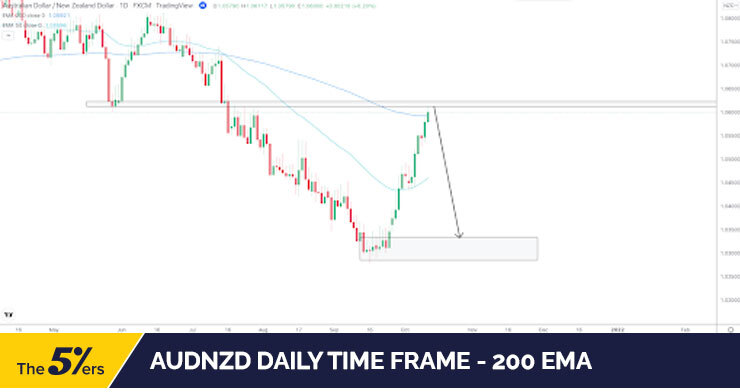
By starting on the daily time frame, we can see that there is a resistance level, alongside the 200 EMA. The trend has been fairly choppy, so we are basing this trading bias purely on the back of this resistance area.
In terms of where the trade could go, we need to look at the ‘traffic’. This is essentially looking at where we think the trade could actually go. Where should the take profit be? Well, in this case, we are looking at the demand zone at the start of the bullish rally.
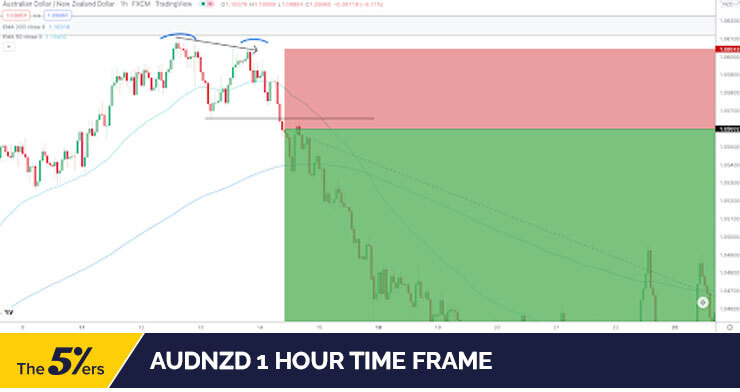
Once the price reaches the level of resistance on the daily chart, we are starting to drop into the lower time frames to find precise trading entries. On the 1-hour time frame, there is a classic double top trading formation. This is a very simple trade to enter as we see a decrease in bullish momentum and the neckline of the trend is broken.
At this point, we enter the trade short and have a risk to reward of 1:5. This was a textbook ‘sniper’ entry, even though it was extremely simple for us to execute!
When you’re looking at increasing risk to rewards to that 1:5 point, you’ll have a much easier time trading on funded accounts.
Take The5ers $100k Bootcamp for example… You have a profit target of 6%. If you’re risking 1% per trade, you’ll be getting fairly far along in each winning trade, which is a great place to be.
Example 2 – EURUSD Sells
Let’s now take a look at EURUSD sells, which resulted in a fairly huge trade for those using multiple time frame analysis to get perfect entries.
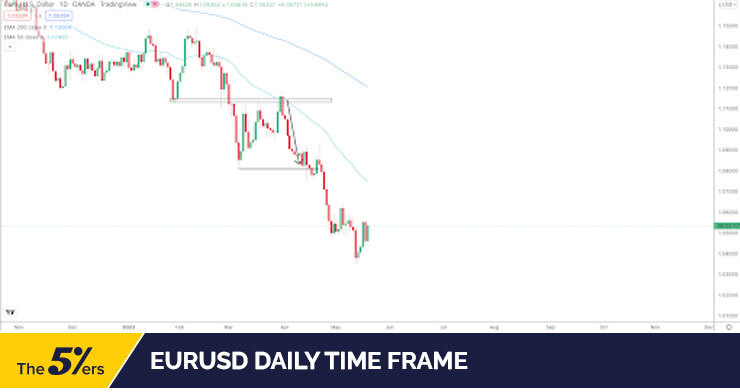
On the daily time frame, the chart was in a steep bearish trend. Price was rejecting a resistance area, alongside a 50 EMA. This is a great example of using multiple confluences in conjunction to provide great trading opportunities.
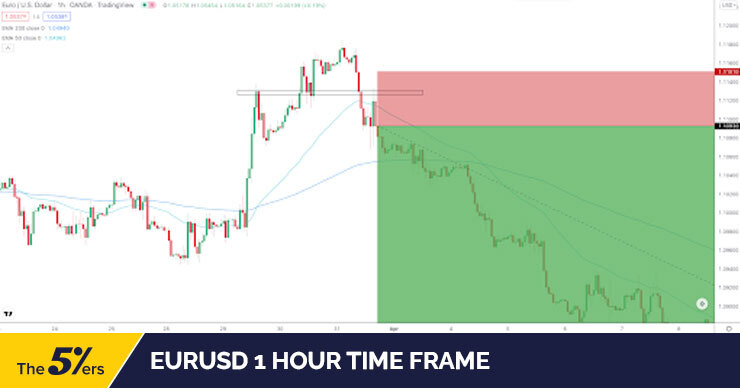
By dropping down to the 1-hour time frame, we can see a head and shoulders trading formation. This is great as it’s very simple to trade!
This allowed us to get into a short position on EURUSD with a risk to reward of 1:5. Managing to obtain these high risk to reward trades is key if you’re looking to get funding with prop firms as you’re ideally looking to maximize opportunity in every single trade!
In Conclusion – How Do You Get Sniper Entries On Forex Trades?
In short, getting great entries in forex trades comes down to using multiple time frame analysis…
- Find a bias using technical analysis on higher time frames.
- Plan an exit point, using the higher time frames.
- Drop to a lower time frame, for instance, 1 hour / 30 minutes.
- Look for a price action pattern to add confluence to an entry point.
- Take the trade, using the lower time frame pattern.
- Hold trade until the higher time frame target.
I hope this article helps you with your prop firm challenges!



